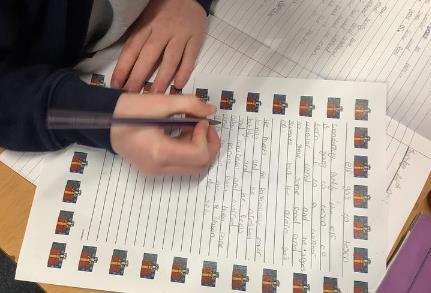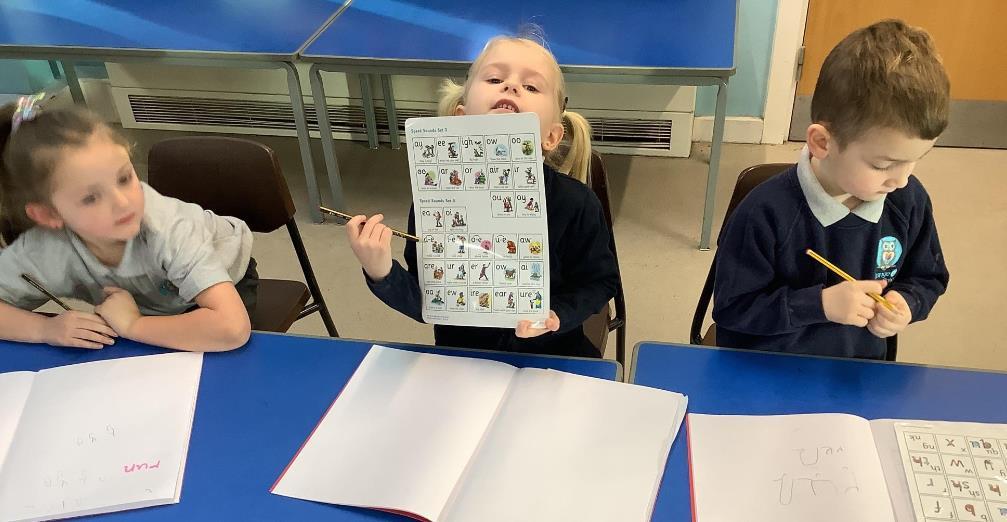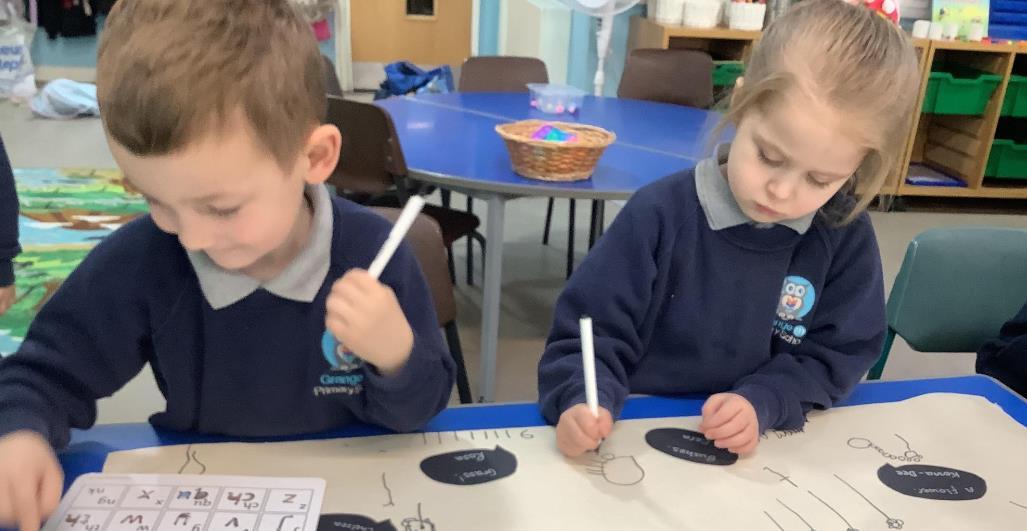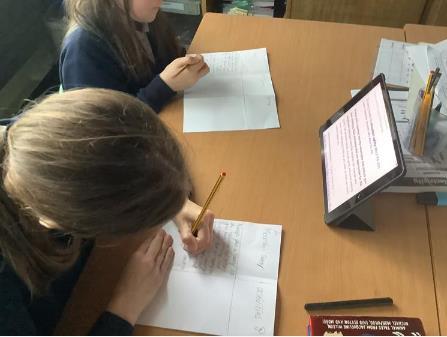Grangers are Writers





Our vision for Writing at Grange Primary is that all children are confident in their ability to write, supported to reach their potential as writers and to reach national expectations (or beyond). We want children to develop writing skills that will enable them to not only apply themselves in an academic context but to have the appropriate skills for the writing needed throughout their lives. We strive to create as many opportunities as possible for children to write creatively and for a purpose. We encourage children to express themselves creatively by writing for different purposes across the curriculum.


• Writing is taught at Grange Primary School using the school’s Writing journey structure. This combines elements of successful writing approaches and lesson input structures such as the Talk for Writing process and using the WAGOLL (what a good one looks like) model.
• Our writing approach is based on recommendations from the Education Edowment Foundation (EEF) planned teaching of vocabulary, pupils planning and evaluating their own writing (including prewriting activities, drafting, editing, revising and sharing). We strive to ensure our children are motivated and engaged through exciting memorable experiences (the hook) and have a reason to write and someone to write for (EEF).
• Through careful modelling and annotating children are taught the grammatical and organisational features of different text types. This knowledge is further secured through two presented pieces referred to as ‘Bill and Betty’ from which the children identify the better example from the success criteria (Shirley Clarke research).
• Spelling, Punctuation and Grammar (SPaG) is mapped out through each year group to ensure complete coverage and progression. There is one stand-alone grammar lesson per week in years 1-6. Relevant areas of grammar in Writing genres are taught throughout units.


• Children in EYFS learn to write following the Read Write Inc programme: this focuses on transcription (spelling and handwriting) and composition (articulating ideas and structuring them in speech, before writing)

• Children are also encouraged to write creatively through varied opportunities in child-initiated learning. The learning environment supports the development of Writing through provision such as Writing stations and role-play areas.

• Focus in Nursery: use large-muscle movements to paint and make marks; use a comfortable grip with good control when holding pens and pencils; show a preference for a dominant hand; develop their phonological awareness; engage in extended conversations about stories, learning new vocabulary. use some of their print and letter knowledge in their early writing; write some letters accurately; write some or all of their name.
• Focus in Reception: to form lower-case and capital letters correctly; spell words by identifying the sounds and then writing the sound with letter/s; write short sentences with words with known sound-letter correspondences using a capital letter and full stop; re-read what they have written to check that it makes sense
• Child-initiated learning and some adult led sessions are recorded on Tapestry.
• Children complete a cold write showing progress from the last unit.
• The Hook – this is a memorable experience related to the topic/outcome such as a visitor, trip, special event. The memorable experience should engage and induce interest and excitement about the topic.
• Explore purpose. What is the purpose of this text? For example – to entertain, persuade, inform etc. Children should have a reason to write and someone to write for.
• Start reading a class novel linked to your topic (which the writing outcome should also be linked to). Build up a bank of linked vocabulary through word of the day(vocab ninja) – these words will be visible in the classroom. These are the ‘Unit Focus Vocabulary’ words.
• Prior knowledge – recap previous experiences that link to the focus/topic. What do the children already know?

Immerse
•Book Talk with the focus text (Y2-6) English Hub Comprehension Structure (YR&1)
•CT share model text. The model text should include the key features and writing elements you want the children to learn, but also have a clearly transferable and identifiable pattern on which they can base their own writing. The model text should be no more than 350 words in length and this will be the text the children learn off by heart.
•Learn and rehearse the model text (the WAGOLL) off by heart and add appropriate memorable actions.
•Children should be immersed in the text through drama/speaking and listening activities (hot seating, freeze framing, conscience alley, interviewing characters etc). Speaking and listening should continue throughout the unit but is especially important in the ‘immerse’ phase.
•Children annotate the model text (WAGOLL) and identify specific features including the grammar that are related to the text type.
•Children are presented with the Pip and Pop texts. Children to decide which text has used all of the model text features.
•Teacher models using the grammar.
•Children practise using the grammar and features of the text in context.
•Modelling of using the grammar and the features of the model text is displayed on flip chart paper on working walls.
•To ensure grammar coverage – one stand-alone grammar lesson is taught per week in KS1 and KS2 following the grammar overview document.
•Teacher modelling using the planning structure.
•Plan the structure of the writing using a school planning template (same template used throughout school and adapted for age and stage).
•Planning to include the grammatical features.
•Develop a success criteria for writing checklist that is displayed on the working wall.
•Children to plan what ‘Unit Focus Vocabulary’ they will use in their writing.
•Mid-point write – including the grammar, features and unit focus words.
•Teachers to model the process of evaluating writing against success criteria and model using purple pen to make amendments.
•KS1 – teachers to mark children’s mid-point write against success criteria and give targets for the FINAL write.
•KS2 – children to be trained in proof-reading and self-assessing their writing against the class success criteria and to set themselves targets for the FINAL write. This may start with teachers setting targets in LKS2.
•Based on their targets and feedback given, children make amendments to their work using purple pen.
•Children plan their FINAL write using the school planning structure. Children should plan to build on the mid-point write- ensuring that targets given are planned for (e.g. use a range of sentences structures). This could be a second draft of the same piece of writing or have a slightly different context using the same features and grammar.
•Refer back to success criteria.
•Children to complete their FINAL write.
•Once proof-read for errors, children should have the opportunity to ‘publish’ their writing and share/perform with peers.
At least one week after finishing the FINAL write, teachers should plan for children to complete a HOT write to assess the skills taught in the unit. The HOT write should be assessed against the year group criterion assessment grids.
What impact has the Writing journey had?
•There is a clear sequence and pedagogy for teaching writing across school. This is evident in learning environments and in children’s books.

•The next step is to secure QFT in writing across school to ensure better outcomes in line with national. This will be done through staff CPD and showcasing areas of strength across school to share good practice.
What assessment takes place in Writing?
•Children complete a piece of writing at the end of every unit which is assessed by class teachers and used to inform judgments.
•Whole school moderation of writing is completed three times a year.

•Cross-school moderation of writing takes place with other schools in the MAT.
•The Writing lead will monitor the end of unit assessments across school.

Writing is supported through ‘on the day’ interventions and small group work. Pupils are extended through targeted group work. Children in year 3 and 4 still accessing phonics to develop reading, writing and spelling follow the Read, Write, Inc programme and if required children in year 5 and 6 access the Freshstart programme.

We aim to provide as many opportunities as possible for children to apply their Writing skills across the curriculum.

This not only showcases the children's skills but leads to a deeper embedding of knowledge/skills and when to use specific grammar and punctuation in different types of Writing genres.



At Grange Primary, we follow the Penpals scheme for Handwriting

• Penpals is a progressive complete handwriting scheme for 3 to 11 year olds.
• Using Penpals ensures a coherent whole-school approach to driving up handwriting standards.


Penpals provides
• A fluent, legible style
• Progression from 3-11 yrs
• 5 clear developmental stages
• Sensible links for application
• An Interactive and multisensory approach.
Penpals leads children through distinct stages:
1. Securing correct letter formation (Key Stage 1/5–6 years)

2. Beginning to join (Key Stage 1/6–7 years)
3. Securing the joins (Lower Key Stage 2/7–9 years)
4. Speed, fluency and developing a personal style (Upper Key Stage 2, 9–11 years)